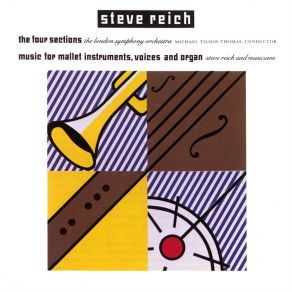Reich: The Four Sections, Music for Mallet Instruments, Voices and Organ
Download links and information about Reich: The Four Sections, Music for Mallet Instruments, Voices and Organ by Steve Reich, London Symphony Orchestra And Chorus, Michael Tilson Thomas. This album was released in 1990 and it belongs to Classical genres. It contains 5 tracks with total duration of 43:00 minutes.

|
|
|---|---|
| Artist: | Steve Reich, London Symphony Orchestra And Chorus, Michael Tilson Thomas |
| Release date: | 1990 |
| Genre: | Classical |
| Tracks: | 5 |
| Duration: | 43:00 |
| Buy it NOW at: | |
| Buy on iTunes $9.99 | |
Tracks
[Edit]| No. | Title | Length |
|---|---|---|
| 1. | The Four Sections: I. Strings (With Winds and Brass) | 11:25 |
| 2. | The Four Sections: II. Percussion | 2:29 |
| 3. | The Four Sections: III. Winds and Brass (With Strings) | 5:54 |
| 4. | The Four Sections: IV. Full Orchestra | 6:14 |
| 5. | Music for Mallet Instruments, Voices and Organ | 16:58 |
Details
[Edit]These two long pieces may be Reich's least ambitious music, but they're easy to make an acquaintance with — unlike Drumming and Tehillim. The Four Sections is performed by the London Symphony Orchestra with Reich's percussion ensemble, and yet manages to project more personality than the ensemble alone does on Music for Mallet Instruments, Voices and Organ. The Four Sections is plain enjoyable. Under Michael Tilson Thomas' baton, the melodic patterns are pleasing, while the woodwinds and strings maintain the same bright, sharp momentum as the ensemble. Like Roy Lichtenstein's cover art, the title refers to the sections of the orchestra, with each section granted its own entrance and brief solo moments. You could even whistle some of it, but probably won't unless you can provide your own drone. Side two is where the lack of ambition isn't quite enough. The percussion and chanted voices of Music for Mallet Instruments, Voices and Organ get across by recalling the pulsing orchestrations of The Desert Music and the glassine harmonies of Music for 18 Musicians. But using Nurit Tillis' organ chords seems almost like cheating. The charm of Reich's finest minimalist experiments was to let harmony and rhythm dig themselves out of the woodwork — or the wallpaper, in some peoples' opinion. The organ tends to resolve the harmonies too quickly, like it's rushing the percussionists along.